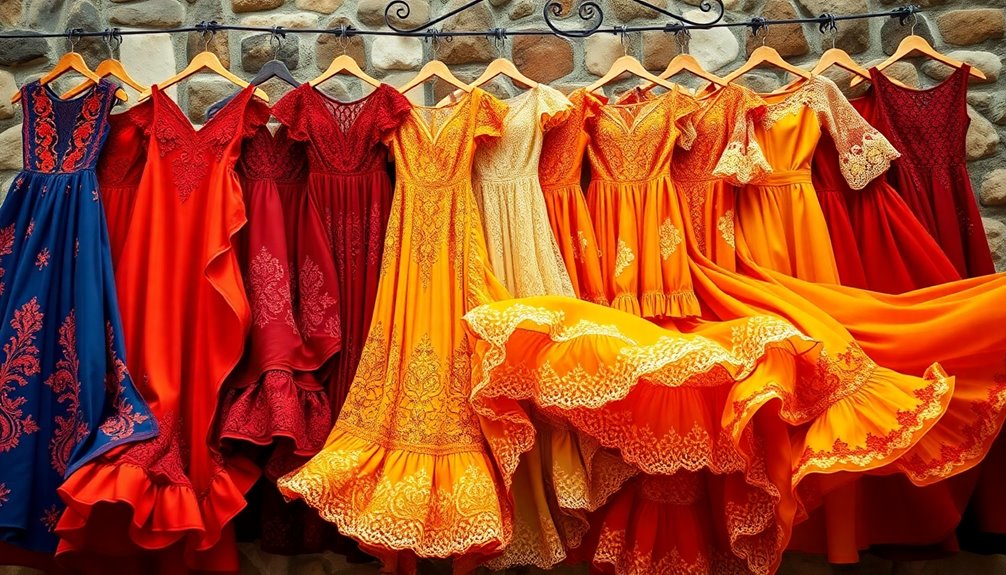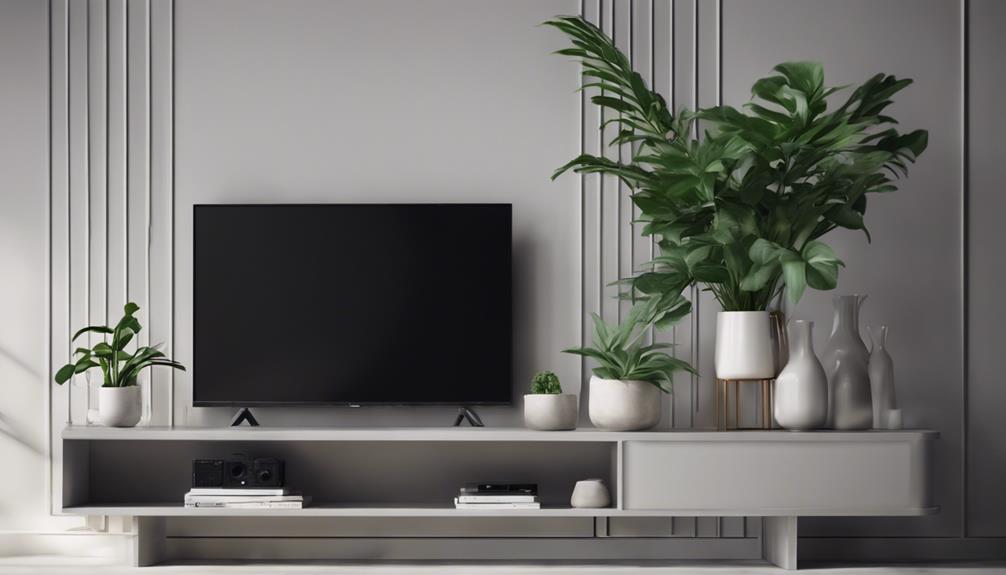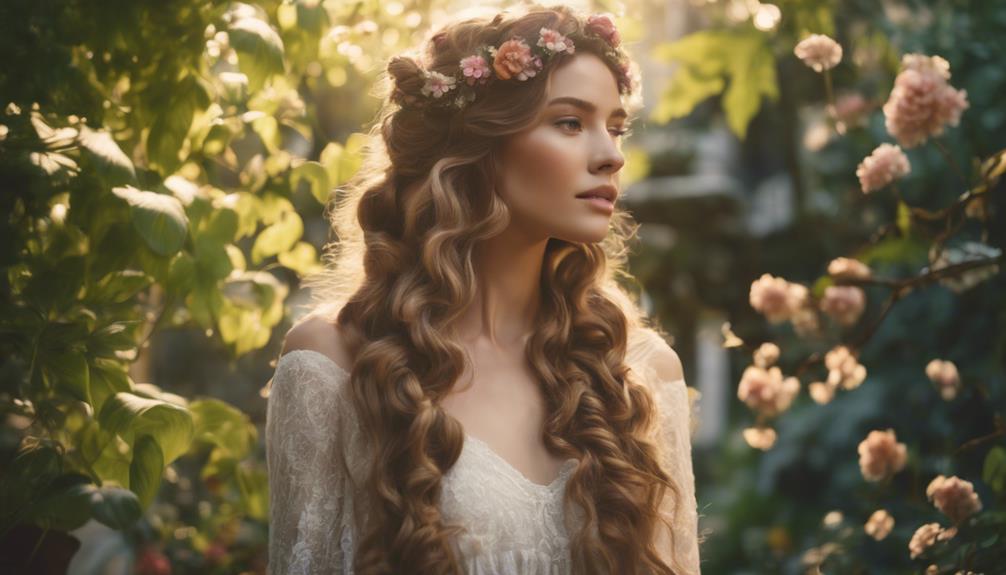Spanish dresses showcase a captivating blend of history and modern flair, offering styles that truly transcend time. You'll notice intricate embroidery and rich fabrics reflecting the country's diverse cultural heritage. From the iconic flamenco dresses worn during festivities to elegant gowns that grace the royal court, these garments celebrate both tradition and innovation. Today's designers are merging sustainable practices with timeless designs, ensuring Spanish fashion remains relevant. Whether you're eyeing a casual piece or something more festive, there's a dress for every occasion. Explore further to uncover the nuances and characteristics that make these styles so unforgettable.
Key Takeaways
- Spanish dresses showcase intricate embroidery and luxurious fabrics, reflecting the country's rich cultural heritage and status symbolism throughout history.
- The flamenco dress exemplifies traditional Andalusian style, highlighting Spain's diverse cultural influences and regional fashion variations.
- Modern Spanish fashion merges traditional designs with innovative elements, emphasizing sustainability through eco-friendly materials and ethical practices.
- Iconic styles like the "traje de flamenca" remain timeless, celebrated during festivals and local celebrations, preserving cultural identity.
- Contemporary designers and labels blend classic aesthetics with modern flair, revitalizing Spanish fashion on international platforms while honoring tradition.
Origin and historical background of the fashion trend/style
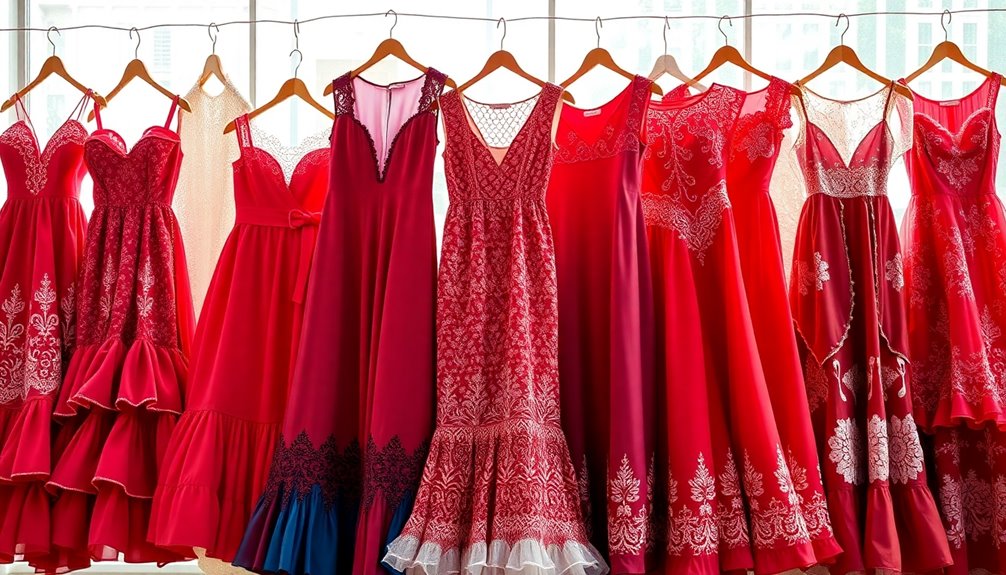
When you explore the origins of Spanish dresses, you'll notice how cultural shifts have played a significant role in their evolution.
Royal patronage has also influenced styles, as nobility often set trends that trickled down through society.
Understanding these factors helps you appreciate the rich history behind each garment.
Cultural Shifts in Fashion
Spanish fashion has undergone remarkable transformations over the centuries, deeply influenced by diverse cultures and historical events.
During the Spanish Golden Age, you'd notice extravagant styles at the royal court that showcased opulence. This period marked a significant shift in fashion history, as traditional Andalusian elements, like the flamenco dress, emerged. These vibrant pieces reflect Spain's rich cultural heritage through their bold colors and intricate designs.
In the 1490s, Spanish fashion began to gain popularity beyond its borders, particularly in Milan, where women's garments like the gamurra displayed luxurious fabrics and exquisite detailing. Jewelry and accessories also became essential, not just for adornment but as symbols of social status.
Renaissance pieces often featured family mottos and precious materials that indicated wealth and influence.
As you observe the evolution from medieval to modern aesthetics, higher waistlines and layered garments stand out, illustrating the dynamic interplay between tradition and innovation.
These cultural shifts in fashion reveal how Spanish fashion has continually adapted, embodying a narrative that celebrates its past while embracing new influences.
Royal Patronage and Influence
Royal courts have long been the epicenters of fashion evolution, and in Spain, this influence reached its peak during the reign of monarchs like Philip IV. His court was a trendsetter, dictating styles that echoed throughout Europe. The luxurious garments worn by Spanish nobility became symbols of power and prestige, often showcased in elaborate ceremonies.
You can see these opulent styles depicted in oil on canvas paintings, which capture the essence of royal fashion.
The marriage of Beatrice d'Este to Ludovico il Moro Sforza in 1491 is another pivotal moment, as her integration of Spanish styles into Milanese fashion marked a cultural exchange that enriched both regions.
The Sforza family, recognized for their wealth, adorned themselves in silk velvet and gold brocade, further solidifying the link between royal identity and fashion.
In the Museum of Art, you'll find examples of garments that not only reflect Spanish heritage but also the broader influence of royal attire on neighboring countries.
These garments served as visual representations of status, showcasing how royal patronage played a critical role in the evolution of Spanish fashion.
Key Characteristics
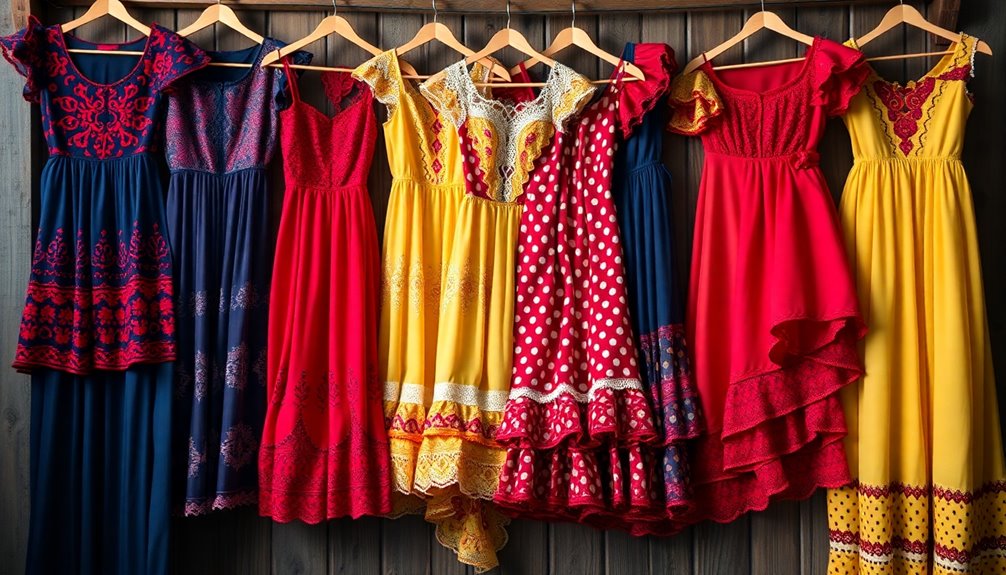
When you explore Spanish dresses, you'll notice the stunning intricate embroidery and embellishments that define their elegance.
Rich brocade and velvet fabrics add depth and texture, creating a luxurious look.
Additionally, embroidered silk gowns showcase the artistry and craftsmanship that are hallmarks of Spanish fashion.
Intricate Embroidery and Embellishments
While exploring the world of traditional dresses, you'll quickly notice that intricate embroidery serves as a defining characteristic, showcasing the rich cultural heritage of Spain. This art form often features motifs that reflect regional heritage and cultural symbolism, making each piece truly unique.
You'll find that vibrant colors and patterns in the embroidery can signify social status and occasion, with specific designs reserved for festive or ceremonial attire. Embellishments like lace, pearls, and gemstones enhance the opulence of these garments, making them visually striking and adding a touch of luxury.
Techniques such as goldwork and silk thread embroidery create depth and texture, elevating the craftsmanship to an extraordinary level. You'll also appreciate how accessories, including embroidered shawls and detailed belts, complement the overall aesthetic.
These embellishments not only highlight the beauty of the dresses but also showcase the importance of detail in Spanish fashion. When you wear or admire these dresses, you're not just looking at fabric; you're witnessing a tapestry of tradition, artistry, and cultural pride woven into every stitch.
Rich Brocade and Velvet
Rich brocade and velvet stand out as the epitome of luxury in Spanish dresses, instantly elevating any garment. These fabrics are characterized by their intricate patterns and textures, signifying wealth and status.
Brocade typically features raised designs crafted through a weaving technique that incorporates gold or silver threads, producing a stunning shimmering effect. You'll find that this opulence makes it perfect for formal occasions.
Velvet, on the other hand, boasts a soft and plush surface that adds depth and richness to any attire. Its unique weaving process creates a luxurious feel that's hard to resist.
Both brocade and velvet are often embellished with elaborate embroidery, further enhancing their grandeur and making them ideal for celebrations and special events.
When you wear garments made from these rich fabrics, you're not just embracing luxury; you're also connecting with Spain's cultural heritage. Each piece reflects regional diversity and tradition, often showcased during festivals or significant gatherings.
Embroidered Silk Gowns
Adorned with intricate designs, embroidered silk gowns are a stunning representation of craftsmanship and elegance in Spanish fashion. These gowns stand out due to their elaborate patterns, often featuring floral or geometric motifs that highlight the artisans' skill in fabric manipulation.
The luxurious silk fabric provides a rich texture and vibrant colors that enhance their visual allure. You'll notice common embellishments like gold thread embroidery and pearls, which add a touch of opulence, signifying the wearer's wealth and status. This element of luxury is a key characteristic, making these gowns not just clothing, but symbols of nobility.
Typically, the structure of embroidered silk gowns includes fitted bodices paired with flared skirts. This design accentuates the waist while allowing ease of movement, making the wearer feel both graceful and comfortable.
Historically, these gowns trace back to the Spanish Golden Age, where they were worn by the elite and depicted in various artworks. They embody a timeless elegance that continues to inspire modern fashion, ensuring that embroidered silk gowns hold a cherished place in Spanish dress history.
Modern Interpretation
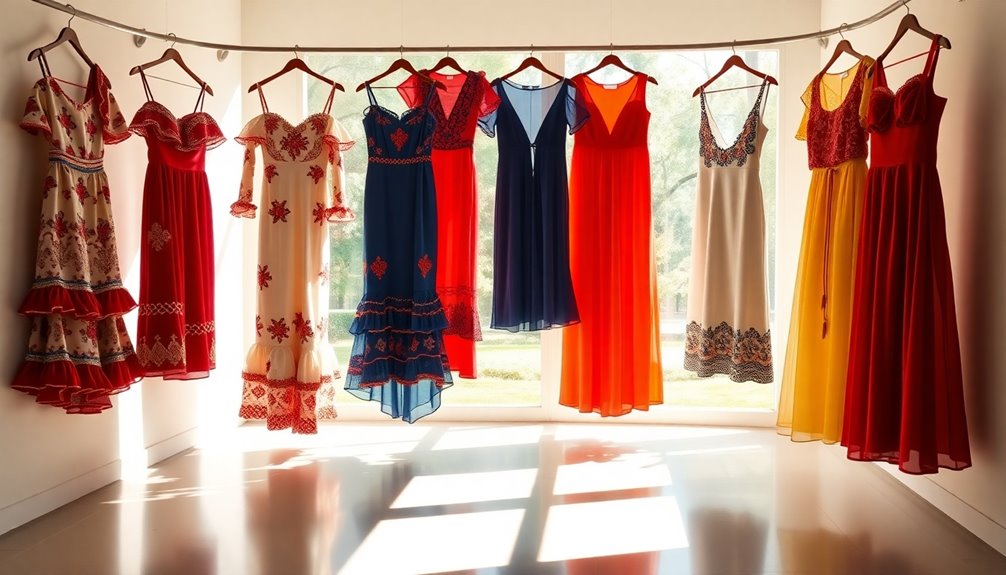
Modern Spanish fashion is transforming, as designers embrace sustainable fabric choices that reflect eco-conscious values.
You'll notice contemporary labels are merging traditional styles with innovative designs, creating fresh looks that resonate today.
Plus, fashion-forward Spanish actresses are championing these trends, showcasing the vibrant evolution of Spanish dresses on and off the red carpet.
Sustainable Fabric Choices Emerging
Sustainability is becoming a cornerstone of contemporary Spanish fashion, as designers increasingly embrace eco-friendly materials like organic cotton, linen, and recycled fabrics.
You'll notice that many brands are responding to your demand for eco-friendly products by adopting transparent supply chains and ethical manufacturing processes.
It's refreshing to see how modern Spanish designers are blending traditional craftsmanship with sustainable practices, ensuring that artisanal techniques are preserved while minimizing waste and promoting ethical labor.
Fashion weeks in cities like Madrid are showcasing collections that emphasize sustainability, featuring innovative designs that marry classic Spanish aesthetics with modern eco-conscious principles.
You can appreciate how the use of sustainable fabrics not only demonstrates a commitment to environmental responsibility but also resonates with a new generation of consumers like you, who value authenticity and cultural heritage in your clothing choices.
In this evolving landscape, your choices play a critical role.
By opting for dresses made from sustainable materials, you support an industry that respects the planet and its people.
Embrace this shift, and you'll find that Spanish fashion isn't only stylish but also aligned with your values.
Contemporary Spanish Fashion Labels
Contemporary Spanish fashion labels are redefining the landscape of style by fusing traditional elements with innovative design. Designers like Juan Vidal and Agatha Ruiz de la Prada infuse their collections with vibrant colors and bold patterns, showcasing Spain's rich cultural heritage.
You'll find that these labels not only celebrate tradition but also embrace modern aesthetics.
Madrid Fashion Week stands as a significant platform where both emerging and established designers unveil their latest collections, drawing international attention. As you explore this vibrant scene, you'll notice the unique interpretations of Spanish style from brands like Desigual and Mango.
They merge casual wear with artistic flair, making their mark in the global fashion industry.
The increasing presence of Spanish fashion houses in international markets signals the global influence of Spanish design. These brands adapt seamlessly to contemporary trends, proving their versatility and creativity.
You'll appreciate how these contemporary labels champion sustainability and innovative approaches, ensuring that their impact goes beyond mere aesthetics.
In this dynamic landscape, contemporary Spanish fashion labels invite you to experience a refreshing blend of tradition and modernity, embodying the spirit of Spain in today's fashion world.
Fashion-Forward Spanish Actresses
Spanish actresses are redefining red-carpet fashion by blending traditional elements with cutting-edge styles. You'll notice how they incorporate ruffles and vibrant colors into contemporary silhouettes, creating a unique aesthetic that honors their cultural heritage while staying current with modern trends.
Actresses like Penélope Cruz and Paz Vega frequently showcase flamenco dresses at high-profile events, allowing the dramatic movement and flair of these garments to take center stage.
The influence of renowned Spanish designers such as Manuel Piña and Agatha Ruiz de la Prada is palpable in their fashion choices. These actresses often opt for pieces that marry traditional craftsmanship with innovative designs, demonstrating the versatility of Spanish fashion.
In recent years, they've also embraced sustainable fashion, selecting outfits made from eco-friendly materials, which reflects a commitment to ethical considerations without sacrificing style.
Additionally, fashion-forward Spanish actresses enhance their looks with accessories like shawls and fans, paying homage to the rich history of Spanish attire. This blend of tradition and modernity not only elevates their red-carpet presence but also sets a new standard for fashion that resonates with audiences worldwide.
Styling Tips
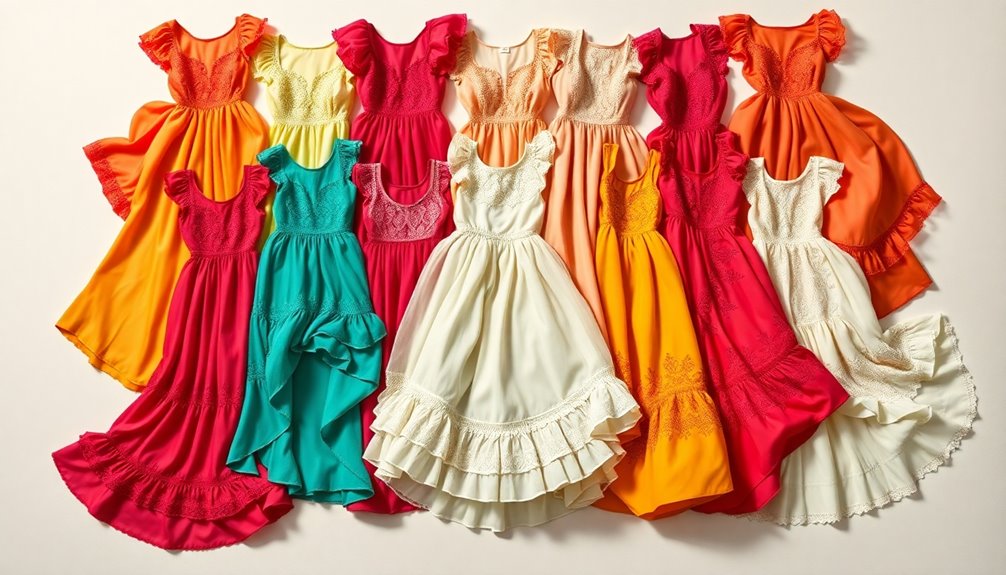
When you're styling your Spanish dress, consider adding a timeless lace shawl for an elegant touch.
Traditional mantilla styles can elevate your look and connect you to the rich cultural heritage.
Layering different textures and patterns not only adds depth but also showcases your unique sense of style.
Timeless Spanish Lace Shawl
A timeless accessory that transforms any outfit, the Spanish lace shawl, or mantón, is perfect for adding a touch of elegance and cultural flair. Adorned with intricate floral patterns and fringes, this stunning piece is a staple in traditional Spanish attire. You can wear it to festivals or cultural events, showcasing the craftsmanship that has been passed down through generations.
For styling, consider draping the shawl gracefully over your shoulders for a classic, sophisticated look. Alternatively, tying it at the waist gives a contemporary twist that can elevate casual outfits. The versatility of the mantón allows it to complement flamenco dresses beautifully, making your ensemble not only elegant but also culturally significant.
If you're looking for a statement piece, the mantón truly shines. It enhances simple outfits with its rich textures and elaborate designs, making it suitable for both casual outings and formal occasions.
Don't hesitate to experiment; whether you're dressing up or down, this timeless shawl is sure to elevate your style and add a unique flair that celebrates Spanish heritage.
Traditional Spanish Mantilla Styles
Embrace the elegance of traditional mantilla styles, which are essential for any formal occasion in Spain. These exquisite lace or silk shawls, often associated with religious ceremonies and festivals in Andalusia, elevate your look to new heights.
To achieve an authentic appearance, start by selecting a mantilla that reflects the occasion. Black mantillas symbolize mourning, while white ones are perfect for festive events, showcasing your social status and the event's significance.
To style your mantilla, use a peineta, a traditional comb that lifts the fabric and adds sophistication. This accessory not only enhances your hairstyle but also complements the intricate designs of the lace, which often feature floral motifs or geometric patterns.
When pairing your mantilla, opt for a traditional flamenco dress or regional attire to create a cohesive ensemble. Additionally, choose jewelry that enhances your look without overpowering it. Simple earrings or a delicate necklace can beautifully complement the elegance of your mantilla.
Layering Textures and Patterns
Layering textures and patterns adds depth and richness to your Spanish-inspired outfits, allowing you to showcase your unique style while honoring tradition.
To start, mix different fabric types like silk and linen to create a visually dynamic ensemble that reflects the vibrancy of traditional Spanish attire. Consider incorporating contrasting colors and patterns, such as floral prints paired with solid hues, to enhance your overall aesthetic and draw attention to specific elements of your look.
Accessories are crucial in this layering game; pairing flamenco dresses with shawls and fans not only adds depth but also emphasizes your cultural heritage.
The ruffles and flares typical of flamenco dresses create dramatic layers, enhancing movement and fluidity in your outfit.
For a sophisticated layered effect, use items like mantillas or embroidered shawls. These not only introduce texture but also pay homage to traditional Spanish fashion.
Shopping Guide
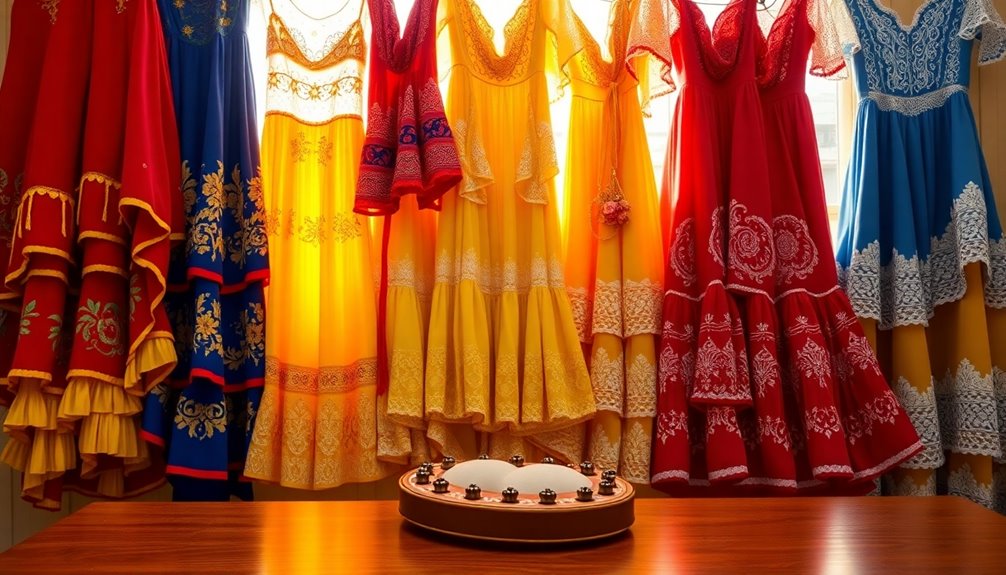
When you're on the hunt for traditional Spanish dresses, it's essential to focus on key styles like the "traje de flamenca," celebrated for its vibrant colors and ruffles that capture the spirit of Andalusian culture.
To find authentic garments, consider visiting local boutiques or browsing online platforms specializing in regional attire. You'll discover intricate embroidery and lace that elevate the traditional look.
Keep an eye out for modern adaptations of classic styles, as contemporary Spanish designers often blend traditional elements with current fashion trends, making these dresses suitable for various occasions.
Understanding the significance of regional variations in Spanish dresses is crucial, too. Each area boasts unique styles and embellishments that reflect local heritage and customs.
If you're a fan of vintage fashion, explore options from the 1950s. These dresses often feature bold prints and full skirts, capturing the post-war influences that resonate with collectors and enthusiasts alike.
Handcrafted Spanish Accessories
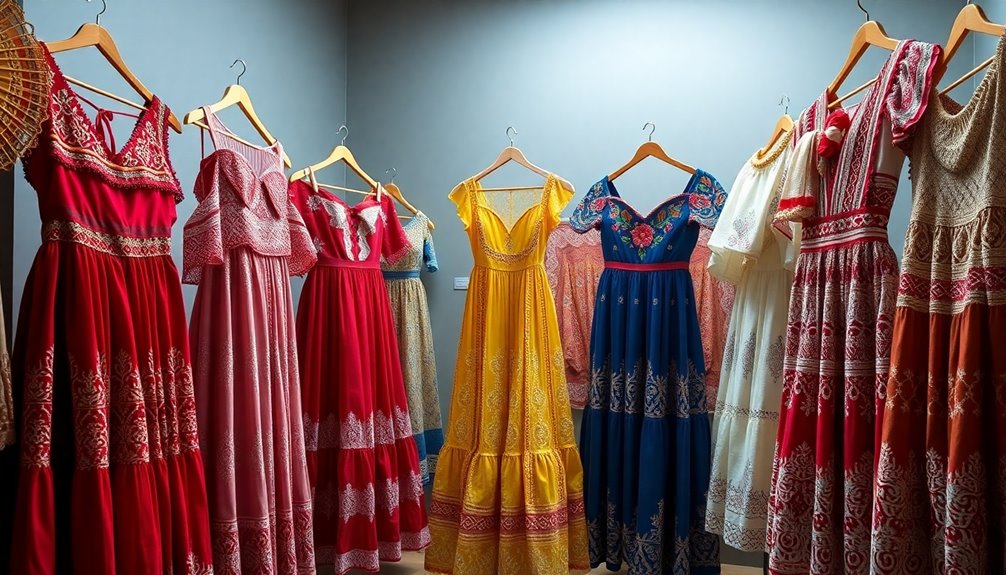
When you explore handcrafted Spanish accessories, you'll find unique jewelry projects that let you express your personal style.
Personalized embroidery options can also add a special touch to your outfits, reflecting your individuality.
These elements not only enhance your look but also connect you to Spain's rich cultural heritage.
Handmade Spanish Jewelry Projects
Diving into the world of handmade Spanish jewelry projects opens up a treasure trove of creativity and tradition.
You'll find that each piece often incorporates traditional materials like silver, gold, and vibrant gemstones, reflecting Spain's rich cultural heritage. As you explore, pay attention to the intricate techniques, such as filigree, where delicate threads of metal are twisted and shaped into stunning designs.
Spanish jewelry often features motifs inspired by nature, history, and regional folklore, showcasing an artisan's creativity and cultural influences.
You might notice how these pieces beautifully complement accessories like mantillas and flamenco dresses, enhancing their elegance and significance during festivals and celebrations.
Visiting workshops or artisan markets across Spain, you'll witness the dedication to preserving these traditional jewelry-making techniques.
Each handcrafted piece tells a story, connecting you to the past while celebrating the artistry of the present.
Whether you're looking to create your own jewelry project or simply appreciate the craftsmanship, you'll find that handmade Spanish jewelry captures the essence of Spanish culture, making it a timeless accessory worth exploring.
Personalized Embroidery Options
Personalized embroidery options for handcrafted Spanish accessories offer a unique way to express your individual style while honoring rich cultural traditions.
These options often incorporate intricate designs that reflect regional motifs and cultural heritage, making each piece truly unique. Artisans skillfully utilize traditional techniques, such as silk thread and gold filigree, to create bespoke embroidery that adds a luxurious touch to your garments and accessories.
You can customize your items with initials, family crests, or meaningful symbols, transforming them into fashionable yet deeply personal keepsakes. This added layer of personalization not only enhances the accessory's aesthetic but also infuses it with sentimental value.
Many Spanish artisans even offer workshops, allowing you to participate in the embroidery process. This immersive experience not only deepens your connection to the craftsmanship but also ensures the final product is a true reflection of your vision.
The integration of personalized embroidery into Spanish fashion highlights a growing trend towards individuality and craftsmanship, bridging the gap between tradition and modern aesthetics.
Cultural Impact
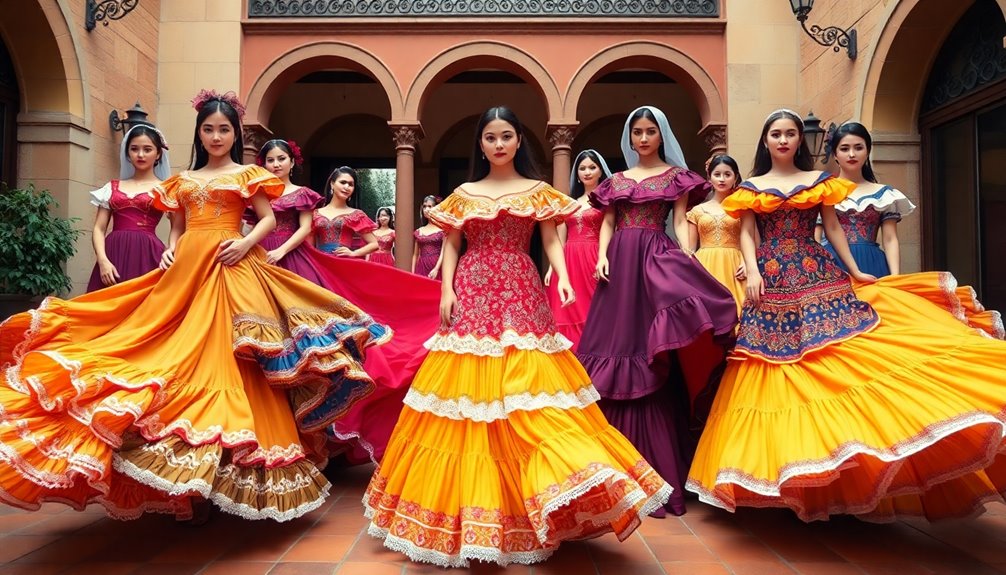
Spanish dresses aren't just about aesthetics; they play a significant role in modern cinema, where filmmakers often use traditional styles to evoke cultural narratives.
You’ll also find that fashion activism is increasingly embracing these garments, advocating for the preservation of cultural heritage in a rapidly changing world. Some designers are even incorporating traditional textiles and techniques into their collections, bringing attention to the importance of respecting and honoring diverse cultures. This trend is expected to continue into 2023 fashion trends, as the demand for ethically-produced and culturally significant clothing grows. As more people become conscious of the impact of their fashion choices, the movement towards preserving and celebrating cultural heritage through clothing is likely to gain even more traction.
This intersection of fashion and film highlights the ongoing relevance of Spanish attire in contemporary discussions about identity and representation.
Film Costumes in Modern Cinema
Film costumes frequently play a crucial role in shaping cultural identities, especially in modern cinema. They reflect and celebrate heritage, as you can see in films like "The Spanish Apartment," which showcases a variety of styles rooted in Spanish culture.
Iconic costumes from "Pan's Labyrinth" and "Carmen" blend historical accuracy with artistic flair, enhancing storytelling while highlighting traditional attire.
Costume designers like Paco Delgado in "Les Misérables" demonstrate how intricate garment details convey character depth and societal context. You can observe how these choices influence viewers' perceptions, bridging the gap between fiction and reality.
Modern films often revive vintage Spanish styles, reintroducing flamenco dresses and traditional accessories that can spark renewed interest in cultural fashion.
The impact of film costumes extends beyond the silver screen. They inspire fashion trends, encouraging designers to incorporate traditional Spanish motifs into their contemporary collections.
When you see these influences in today's fashion, you can appreciate how film costumes not only tell stories but also shape cultural identities and trends, making them a vital aspect of modern cinema.
Fashion Activism and Advocacy
Through the lens of fashion activism, clothing transforms into a powerful tool for advocating social and political change. In Spain, this movement's taken root, with designers utilizing traditional elements to honor regional identities while promoting sustainability.
You'll notice how these collections not only celebrate cultural heritage but also challenge the fast fashion industry, urging consumers to support local artisans and sustainable practices.
Events like Madrid Fashion Week serve as platforms where designers showcase work that reflects societal issues, pushing for social justice. You can see how these collections spark conversations about gender equality and representation, making fashion a voice for the marginalized.
Collaborations between fashion houses and social organizations amplify this cultural impact, raising awareness around identity and diversity.
As you engage with Spanish fashion, you're not just admiring aesthetics; you're participating in a movement that values cultural connections and ethical practices.
Frequently Asked Questions
What Is a Spanish Style Dress Called?
A traditional Spanish style dress is often called a "traje de flamenca." You'll notice its vibrant colors, ruffles, and fitted bodice, making it a striking choice for festivals and cultural events.
If you're looking for something more formal, consider the "mantilla," typically worn with a lace shawl.
Spanish wedding dresses also showcase elaborate designs, often featuring white fabric to symbolize purity.
Each region boasts unique styles, reflecting Spain's rich cultural diversity.
How Did the Moorish Influence Spanish Fashion?
The Moorish influence on Spanish fashion is profound.
You'll notice luxurious fabrics and intricate embroidery that reflect Islamic artistry from the Middle Ages. Flowing silhouettes and layered garments emphasize comfort and elegance, while vibrant colors and patterns add a lively touch to textiles.
Ornate details, like tassels and fringes, showcase Moorish decorative elements, and accessories such as the mantilla beautifully blend these rich cultural traditions, enriching Spain's fashion heritage.
What Are Traditional or Cultural Clothing Styles of the People in Spain?
In Spain, you'll find a rich tapestry of traditional clothing styles that reflect the country's diverse culture.
The flamenco dress, with its vibrant colors and ruffles, is a standout during festivals. You'll also see the mantilla, a beautiful lace scarf worn for formal occasions.
Each region, like Galicia and Jalisco, showcases unique attire, incorporating intricate embroidery and lace, blending historical significance with modern fashion while preserving cultural heritage.
Why Is Spain Famous for Fashion?
Spain's famous for fashion because it beautifully blends tradition and modernity.
You'll find vibrant designs that reflect the country's rich cultural heritage, from flamenco dresses to innovative pieces showcased at Madrid Fashion Week.
Spanish designers are celebrated for their unique craftsmanship, and their works often draw inspiration from historical influences.
With each garment, you can see the dedication to artistry and expression, making Spain a pivotal player in the global fashion scene.
